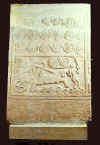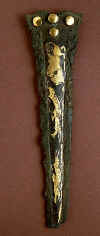The stories behind the plot of the Iliad: why the
Trojan War took place
...Paris, the son of the Trojan king, Priam,
was appointed by Zeus to judge which of three goddesses, Hera, Athene
or
Aphrodite, was the most beautiful. In this contest, known as the
JUDGMENT OF PARIS, each goddess tried to bribe him, and Paris named
Aphrodite, the goddess of love, as the most beautiful. In return, she
promised
him Helen, the most beautiful mortal woman, but there was a slight
problem: Helen was the wife of Menelaos, king of Sparta. When Paris
visited Menelaos, he left with Helen. After the Trojans refused to
return Helen, Menelaos and his older brother, Agamemnon, king of
Mykenai and the most powerful king of the Greek clans, organized a huge
expedition of Greeks against Troy (Ilion).
When the Iliad opens, the Greeks have been besieging Troy for nine
years...
LECTURE OUTLINE
2. ORAL POETRY (Introduction to the Iliad,
pp.
37-40)
-How was the text of the Iliad passed down from ancient times to our
own?
-How are methods of oral composition and oral performance reflected in
the ancient Greek text of the Iliad?
-The building blocks of the Greek oral epic are
repeated phrases, lines or longer sections. These are known as HOMERIC
FORMULAS. Here are examples:
-name + EPITHET (descriptive
adjective): swift-footed Achilleus; grey-eyed Athene; bronze-armoured
Achaians; bronze-pointed spear
-lines: "So he spoke in prayer, and Phoibos
Apollo heard him." (1.43, 457); "But when they had put away their
desire for eating and drinking..." (1.469, 9.92)
-longer passages: description of a sacrifice
and feast (1.458-71, 2.421-32)
-The development and use of Homeric formulas was shaped by several
factors:
-the METER of ancient Greek poetry was
based on the length of syllables as determined by the length of
their vowels; in this respect, the meter is comparable to the quantity
of musical notes (e.g., whole notes,
half notes etc.). In the original Greek, the meter of Homer's
poems was DACTYLIC
HEXAMETER , consisting of six feet (parts) in which each foot was
either a DACTYL (one long + two short syllables) or a SPONDEE
(two long
syllables). The final foot was either a spondee or a trochee (one
long + one short syllable). These are examples of the meter of typical
lines:
3. WRITING, THE AUTHOR AND THE TEXT OF THE ILIAD:
HOMER’S POEMS IN HISTORY
-What is the role of an individual author in the oral poem?
-How did writing and the invention of the GREEK ALPHABET affect
the oral tradition?
4. HISTORY IN THE HOMERIC POEMS
-What is "historical" about Homer's poems? To what periods do
these historical elements refer?
-rediscovery of the BRONZE AGE civilizations of Greece and the
Aegean region
-CRETE: the MINOAN CIVILIZATION
, palace complex at KNOSSOS excavated by ARTHUR EVANS
-mainland Greece: the MYCENAEAN
CIVILIZATION , important sites include MYKENAI, PYLOS
and TIRYNS ; excavators include HEINRICH SCHLIEMANN and
Carl Blegen
-LINEAR A (Minoan) and LINEAR B
(Mycenaean Greek/deciphered by Michael Ventris): Bronze Age syllabic
writing
-How are different "layers" of history preserved in the Homeric poems?



******************************************************************************
FOOD FOR THOUGHT: Consider how the computer and the internet
change how we
read and write. Do you think these changes are having an effect
that is like the way writing affected
the oral epics of ancient Greece?
******************************************************************************
Note: A good reference source for Greek mythology is: The Dictionary of
Classical Mythology by P. Grimal. It is available in the
reference
room of the USF library (BL715.G713 1986).